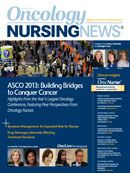The Affordable Care Act: What Nurses Need to Know
A hot topic of discussion at the American Society of Clinical Oncology (ASCO) meeting in June was the Patient Protection and Affordable Care Act (often referred to as the ACA) and what it means for the future of oncology care in the United States.
Lisa Schulmeister, RN, MN, APRN-BC, OCN®, FAAN
Editor-in-Chief OncLive Nursing
Oncology Nursing Consultant, Adjunct Assistant Professor of Nursing Louisiana State Health Sciences Center in New Orleans, Louisiana
A hot topic of discussion at the American Society of Clinical Oncology (ASCO) meeting in June was the Patient Protection and Affordable Care Act (often referred to as the ACA) and what it means for the future of oncology care in the United States. As oncology providers, we are well aware of the drivers for this legislation. Lack of access to medical care, lack of health insurance coverage, rising costs, and an outdated reimbursement system (provider payments based on volume), have all led to a crisis in healthcare. The ACA was enacted to address these issues by improving access to healthcare, improving and rewarding quality care, and decreasing costs.
On March 21, 2010, the ACA was signed into law by President Obama, and on June 28, 2012, the US Supreme Court validated the constitutionality of the legislation. Provisions of the ACA allow young adults to continue healthcare coverage on their parents’ insurance plans until the age of 26, prohibit the denial of coverage to individuals with preexisting conditions (which is very relevant to our patient population), provide incentives for the expansion of Medicaid, and implement significant changes to the delivery system to increase healthcare innovation.
The ACA will expand healthcare coverage to an additional 25 million Americans according to recent estimates by the Congressional Budget Office. Much of this expansion is through the Medicaid program, which will cover childless adults and establish health insurance exchanges that will offer an insurance option for individuals and families who are either unemployed or are not offered insurance through their employer.
All new or renewing private healthcare insurance plans are now required under the ACA to cover the costs of 45 preventive services that were identified by the US Preventive Services Task Force as essential for reducing future medical burden. Covered services relevant to oncology care include colonoscopy screening, Pap testing, and mammograms. The ACA also eliminates any copays, deductibles, and other cost sharing for preventive services. Medicare Part D’s “donut hole”—the gap in coverage that occurs when a beneficiary exceeds the drug coverage limit—is often a concern for people being treated for cancer. Once patients reach the drug coverage limit, they are expected to pay for all of their drug costs until they reach a catastrophic protection level and their drug coverage will resume. The ACA aims to close the gap by providing discounts for generic drugs, subsidizing name-brand drugs, and raising the initial coverage limit to meet the coverage-gap threshold.
The ACA also identifies Essential Health Benefits services that Medicaid and other insurance plans that wish to participate in the healthcare insurance exchanges must cover by 2014: ambulatory services; emergency services; hospitalization; maternity, newborn, and pediatric care; mental health services; prescription drugs; rehabilitative services; and laboratory services. Another benefit of the ACA is that insurance companies will no longer be allowed to deny coverage of routine medical costs for patients participating in a clinical trial.
Also being phased out under the ACA are spending caps that health plans have traditionally set for services that are considered Essential Health Benefits. Before this provision, health plans were able to set an annual or lifetime limit on what they would spend on a beneficiary’s covered benefits, and once this amount was exceeded, patients had to bear further costs of care.
The ACA supports the Physician Quality Reporting System (PQRS) program to leverage incentive payments and payment adjustments for eligible physicians who contribute quality information, and makes the data available to the public. Starting in 2015, the program has the authority to impose a payment penalty if a physician does not adequately meet the reporting requirements or quality standards.
In an effort to reward delivery of high-quality care over high volume of care, the ACA also introduced the bundled payment initiative, which provides reimbursement based on the episode of care and encourages care coordination. Additional cost-savings measures, such as accountable care organizations and medical homes, also are being explored, and oncology nurses will likely be on the forefront of these initiatives.
Innovative Program Reduces Nurse Turnover and Fosters Development
Published: September 12th 2024 | Updated: September 12th 2024The US Oncology Network (The Network) has developed one of the most comprehensive programs in the nation to support the professional development and retention of new oncology nurses.



